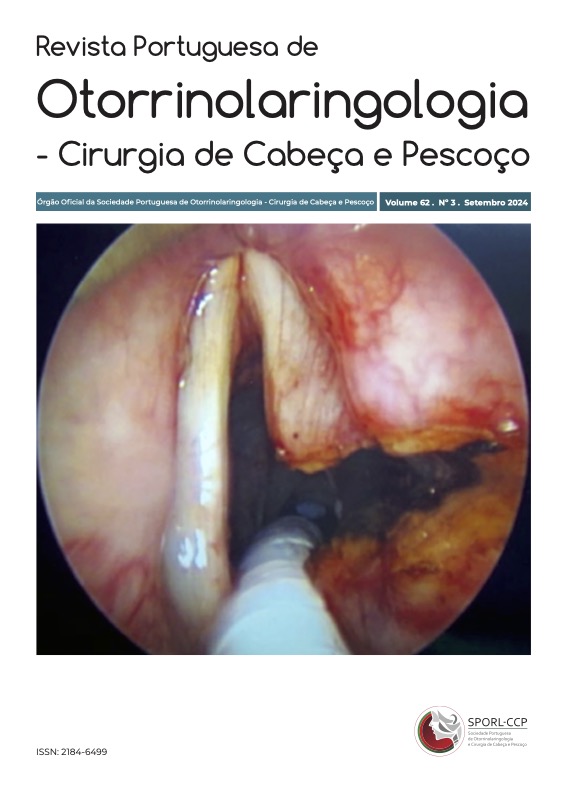Para além da Idade da Pedra: a evolução nasal do Neandertal ao Homem moderno
DOI:
https://doi.org/10.34631/sporl.2177Palavras-chave:
Hominídeos, Fósseis, Nariz, Anatomia comparada, Sistema Respiratório, Evolução biológica, Adaptação ao frio, Termorregulação, Neandertal, Homo SapiensResumo
Introdução: Os Neandertais, nossos parentes extintos, exibiam uma morfologia nasal distinta em comparação com o Homo sapiens.
Objetivos: Este estudo explora essas diferenças através de uma análise comparativa de medidas nasocranianas.
Material e Métodos: Dados sobre as características nasais do Homo Neanderthalensis e Homo Heilderbergensis foram obtidos a partir da literatura paleoantropológica existente, com foco em 16 fósseis. Uma amostra paralela de 38 de crânios de Homo Sapiens foi analisada retrospetivamente mediante tomografia computadorizada (TC), com obtenção de medições relativas à região nasal.
Resultados: Os Hominídeos exibiram cavidades nasais significativamente maiores, com distâncias basion-nasion e basion-prosthion aumentadas, dimensões intercaninas maiores e maior largura e altura nasal em comparação com os humanos modernos. A largura coanal e o índice nasal não diferiram significativamente.
Conclusões: Esses achados sugerem adaptações funcionais na morfologia nasal neandertal, potencialmente auxiliando na termorregulação em ambientes frios. Pesquisas adicionais são necessárias para compreender totalmente o significado evolutivo dessas adaptações.
Downloads
Referências
Weaver TD, Stringer CB. Unconstrained cranial evolution in Neandertals and modern humans compared to common chimpanzees. Proc Biol Sci. 2015 Oct 22;282(1817):20151519. doi: 10.1098/rspb.2015.1519.
Higham T, Douka K, Wood R, Ramsey CB, Brock F, Basell L. et al. The timing and spatiotemporal patterning of Neanderthal disappearance. Nature. 2014 Aug 21;512(7514):306-9. doi: 10.1038/nature13621.
Hublin JJ. The origin of Neandertals. Proc Natl Acad Sci [Internet]. 2009 Sep 22;106(38):16022–7. Available from: https://doi.org/10.1073/pnas.0904119106
Li Q, Chen J, Faux P, Delgado ME, Bonfante B, Fuentes-Guajardo M. et al. Automatic landmarking identifies new loci associated with face morphology and implicates Neanderthal introgression in human nasal shape. Commun Biol. 2023 May 8;6(1):481. doi: 10.1038/s42003-023-04838-7.
Wroe S, Parr WCH, Ledogar JA, Bourke J, Evans SP, Fiorenza L. et al. Computer simulations show that neanderthal facial morphology represents adaptation to cold and high energy demands, but not heavy biting. Proc Biol Sci. 2018 Apr 11;285(1876):20180085. doi: 10.1098/rspb.2018.0085.
Holton NE, Franciscus RG. The paradox of a wide nasal aperture in cold-adapted Neandertals: a causal assessment. J Hum Evol. 2008 Dec;55(6):942-51. doi: 10.1016/j.jhevol.2008.07.001.
Márquez S, Pagano AS, Delson E, Lawson W, Laitman JT. The nasal complex of Neanderthals: an entry portal to their place in human ancestry. Anat Rec (Hoboken). 2014 Nov;297(11):2121-37. doi: 10.1002/ar.23040.
Schwartz JH, Tattersall I. Significance of some previously unrecognized apomorphies in the nasal region of Homo neanderthalensis. Proc Natl Acad Sci U S A. 1996 Oct 1;93(20):10852-4. doi: 10.1073/pnas.93.20.10852.
Franciscus RG. Neandertal nasal structures and upper respiratory tract “specialization.” Proc Natl Acad Sci U S A. 1999 Feb 16;96(4):1805-9. doi: 10.1073/pnas.96.4.1805.
Laitman JT, Reidenberg JS, Marquez S, Gannon PJ. What the nose knows: new understandings of Neanderthal upper respiratory tract specializations. Proc Natl Acad Sci U S A. 1996 Oct 1;93(20):10543-5. doi: 10.1073/pnas.93.20.10543.
Rae TC, Koppe T, Stringer CB. The Neanderthal face is not cold adapted. J Hum Evol. 2011 Feb;60(2):234-9. doi: 10.1016/j.jhevol.2010.10.003.
Weaver TD, Roseman CC, Stringer CB. Were neandertal and modern human cranial differences produced by natural selection or genetic drift? J Hum Evol. 2007 Aug;53(2):135-45. doi: 10.1016/j.jhevol.2007.03.001.
Weaver TD. The meaning of Neandertal skeletal morphology. Proc Natl Acad Sci [Internet]. 2009 Sep 22;106(38):16028–33. Available from: https://doi.org/10.1073/pnas.0903864106.
Ko KH. Hominin interbreeding and the evolution of human variation. J Biol Res (Thessalon). 2016 Jul 16:23:17. doi: 10.1186/s40709-016-0054-7.
Bastir M, Rosas A. Cranial base topology and basic trends in the facial evolution of Homo. J Hum Evol. 2016 Feb:91:26-35. doi: 10.1016/j.jhevol.2015.11.001.
Bräuer G, Leakey RE. The ES-11693 cranium from Eliye Springs, West Turkana, Kenya. J Hum Evol. 1986;15(4):289–312. https://doi.org/10.1016/S0047-2484(86)80055-0
Lacruz RS, Stringer CB, Kimbel WH, Wood B, Harvati K, O'Higgins P. et al. The evolutionary history of the human face. Nat Ecol Evol. 2019 May;3(5):726-736. doi: 10.1038/s41559-019-0865-7.
Bastir M, Rosas A, Gunz P, Peña-Melian A, Manzi G, Harvati K. et al. Evolution of the base of the brain in highly encephalized human species. Nat Commun. 2011 Dec 13:2:588. doi: 10.1038/ncomms1593.
Emes Y, Aybar B, Yalcin S. On the evolution of human jaws and teeth : a review. Bull Int Assoc Paleodont. 2011;5(1):37-47.
Fitch WT. The biology and evolution of speech: a comparative analysis. Annu Rev Linguist. 2018;4:255–79. Doi: 10.1146/annurev-linguistics-011817-045748
Barney A, Martelli S, Serrurier A, Steele J. Articulatory capacity of Neanderthals, a very recent and human-like fossil hominin. Philos Trans R Soc Lond B Biol Sci. 2012 Jan 12;367(1585):88-102. doi: 10.1098/rstb.2011.0259.
Lieberman P. The Evolution of Human Speech. Curr Anthropol [Internet]. 2007 Apr 6;48(1):39–66. Available from: http://www.jstor.org/stable/10.1086/509092
Albessard-Ball L, Balzeau A. Of tongues and men: a review of morphological evidence for the evolution of language. J Lang Evol. 2018 Jan 1;3(1):79–89. doi.org/10.1093/jole/lzy001
Neelapu BC, Kharbanda OP, Sardana HK, Balachandran R, Sardana V, Kapoor P. et al. Craniofacial and upper airway morphology in adult obstructive sleep apnea patients: A systematic review and meta-analysis of cephalometric studies. Sleep Med Rev. 2017 Feb:31:79-90. doi: 10.1016/j.smrv.2016.01.007
de Azevedo S, González MF, Cintas C, Ramallo V, Quinto-Sánchez M, Márquez F. et al. Nasal airflow simulations suggest convergent adaptation in Neanderthals and modern humans. Proc Natl Acad Sci U S A. 2017 Nov 21;114(47):12442-12447. doi: 10.1073/pnas.1703790114.
Li C, Jiang J, Kim K, Otto BA, Farag AA, Cowart BJ. et al. Nasal structural and aerodynamic aeatures that may benefit normal olfactory sensitivity. Chem Senses. 2018 Apr 23;43(4):229-237. doi: 10.1093/chemse/bjy013.
Jacobs LF. The navigational nose: a new hypothesis for the function of the human external pyramid. J Exp Biol. 2019 Feb 6;222(Pt Suppl 1):jeb186924. doi: 10.1242/jeb.186924.
Downloads
Publicado
Como Citar
Edição
Secção
Licença
Direitos de Autor (c) 2024 Os autores mantêm os direitos de autor deste artigo.

Este trabalho encontra-se publicado com a Licença Internacional Creative Commons Atribuição-CompartilhaIgual 4.0.






